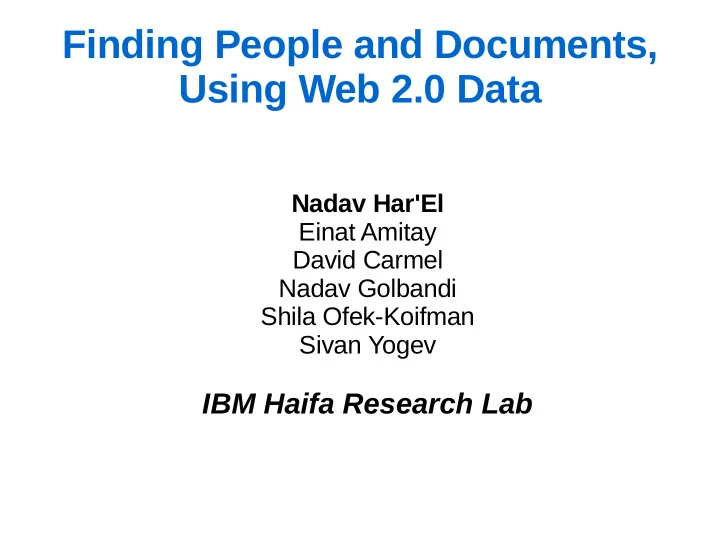

Finding People and Documents, Using Web 2.0 Data Nadav Har'El Einat Amitay David Carmel Nadav Golbandi Shila Ofek-Koifman Sivan Yogev IBM Haifa Research Lab
Web 2.0 data ● The traditional Web: – Considerable effort to publish content. – Most users are information consumers only. ● Web 2.0: – Ordinary users easily produce information. – Services such as forums, wikis, blogs, collaborative, bookmarking, etc.
Web 2.0 data ● Web 2.0 data gives us – New wealth of information (produced by ordinary users) – New types of information – social information : ● User-supplied metadata for documents (bookmarks, tags, ratings, comments) ● Relationships between people and documents (who wrote a document, who tagged it, etc.) ● Relationships between people and people.
Social search ● Our goal: use social information to improve search in an enterprise intranet (IBM). – Improve the relevance of document results: ● Tags and comments supply more text to be searched. ● Important documents can be recognized by user activity around them (bookmarking, comments, etc.) ● Our research shows precision is vastly improved over standard full-text search (P@10 between 0.7-0.8). – How use person-document relationships?
Outline of this talk ● Unified search: document & person. ● How the document-person relationships enable person search. ● Implementation of the unified search using faceted search . ● The system and its evaluation.
Unified search ● When in need of information, – Some people like to find a written document . – Some people like to find a person to ask. – Most people are between these extremes. – And each source is better in different situations.
Unified search ● So given a query, we want the search engine to return: – A ranked list of documents relevant to the query – A ranked list of people interested in the query topic ● We also want to use people in queries : – “John Smith” – information retrieval “John Smith”
Person search ● Using person-documents relationship: ● A person is relevant to a query if he or she are related to documents relevant to the query. – Given a query – Find all documents relevant to this query – Find people relevant to these documents ● [McDonald & Ounis, Balog & de Rijke, 2006] ● But how to score?
Person search ● Returning to the Vector Space Model: – In VSM, documents define relevance matrix D, between documents and terms. – A query is also a vector q . Search results: Dq . – Document-person relationships define relevance matrix P between documents and people . – P T D is a relevance matrix between terms and people . P T Dq are (scored) people search results.
Person search ● But using P T Dq directly is inconvenient: – Keeping P T D up-to-date is hard – Document and person search done using two different matrices ( D and P T D ) – Lose non-VSM search engine features (phrase, etc) ● We prove that the following more-useful formula is equivalent:
Person search ● Score for person i, ( P T Dq ) i = ● Already proposed in Balog & de Rijke, with different (probabilistic) justification. ● Can be calculated using faceted search :
Faceted search ● Commonly used technique for adding navigation to a search engine. ● A facet is a single attribute of the document. ● In a camera search application, documents might have a “Brand” and “Price” facets. ● To each document, several categories are added. For example “Brand/Sony” or “Price Range/$90-$40”.
Faceted search ● Simplest faceted search goes over matching documents, counting for each category the number of documents:
Faceted search ● In our application, a “Related Person” facet. ● Categories like “Related Person/John Smith” attached to document, with a weight . ● Instead of just counting, can aggregate expressions. For person i category:
Faceted search ● More faceted search features we use: – Query-independent static score for categories ( category boost) . – Special query for “Person P” returns all documents in this category, sorted by the category weight.
The Social Search Application ● Data from some of IBM's internal Web 2.0 sites: – 67,564 blog threads (thread = entry + comments) ● Content: Blog entry, comments, tags ● Person facet: author, commenter, bookmarker – 337,345 bookmarks to 214,633 Web-pages ● Content: Titles, user descriptions, tags ● Person facet: bookmarker – 15,779 people who created that content
The Social Search Application
Evaluation ● We return both documents and people for every query – need to evaluate precision of both. ● Document results evaluated as usual: – 50 real queries chosen from query logs – The top results judged by humans as being “relevant”, “very relevant” or “irrelevant”. – Very high precision demonstrated (P@10 ~ 0.8). – Much better than full-text enterprise search.
Evaluation ● “Related people” evaluation – large user study – 60 real queries chosen from query logs. – 100 related people retrieved for each query. – Each person is mailed listing 6-15 queries (some believed to be relevant and some irrelevant): Rate 1-5 whether the topic is relevant to you. – 612 people responded, from 116 IBM locations in 38 countries. – The ranked list of related people we generate are compared to these self-ratings using NDCG metric. – Compare full scoring formula to simpler ones.
Evaluation ● Evaluation results: Aggregation NDC NDC NDC expression G 10 G 20 G 30 Count only “votes” 0.71 0.69 0.68 Sum of scores “CombSUM” 0.75 0.73 0.72 +relationship weights 0.76 0.74 0.73 +person static score: ief 0.77 0.76 0.74
Conclusions ● Web 2.0 data provides an excellent source for document and people search in an enterprise. ● Unified (document/person) search can be easily realized using faceted search. ● VSM justification for the scoring formula. ● In a 612-respondent study, the full scoring formula was shown better than simpler versions. ● Also strengthens previously published results by using with a new data set and evaluation.
Recommend
More recommend